19 Outdoor Palm Plants for Garden Landscaping

Outdoor palm plants are popular for adding a tropical touch to gardens and landscapes. Small or compact palm trees and plants are ideal for front-of-house planting and backyards with limited space. You can plant the palms as focal points in landscaping or in containers as potted plants on patios and decks. Known for their iconic palm fronds or leaves and unique appearance, outdoor palm plants can enhance a tropical garden’s aesthetics.
Outdoor palm plants come in a variety of sizes and types. Some are small palm trees with arching feather-like fronds. Other palms are multi-stemmed plants with fan-like leaves that enhance garden landscapes. Whether you choose a tall palm tree or low-growing palm plants, they provide a lush and exotic atmosphere to any outdoor space.
This article is a guide to choosing outdoor palm plants for growing in gardens or landscapes. Descriptions and pictures of different palm species will help you choose the best palm plants to create a tropical and exotic atmosphere in your outdoor space.
What Are Outdoor Palm Plants?
Some of the best outdoor palm plants for front or back yards are dwarf palmetto, blue palmetto, lady palms, and pygmy date palms. Some of these palm plants thrive in colder climates throughout the year. Other tropical palms grow outdoors in containers in the summer and require overwintering indoors in the winter.
Outdoor palm plants are tropical or subtropical plants in the family Arecaceae. Palm plants feature large, feather-like, or fan-shaped leaves called fronds. Palms thrive in warm, sunny climates, usually in USDA zones 9 and above.
Outdoor palm trees and plants come in various species, from the tall majestic royal palm (Roystonea regia) to the compact pygmy date palm (Phoenix roebelenii) or the eye-catching Chinese fan palm (Livistona chinensis) and the European fan palm (Chamaerops humilis).
Related reading: The complete guide to palm trees.
Types of Outdoor Palm Plants (with Pictures)
Let’s look in detail at species of palm plants for growing outdoors. These compact palms are generally suitable for planting in the ground or containers for landscaping front or backyards.
Areca Palm (Dypsis lutescens)

The areca palm is a popular outdoor palm plant known for its large arching pinnately compound green fronds. The elegant tropical palm has multiple stems and feather-like leaves and produces clusters of small flowers. Thanks to its graceful and tropical look, areca is an ideal palm for planting indoors in containers or outdoors.
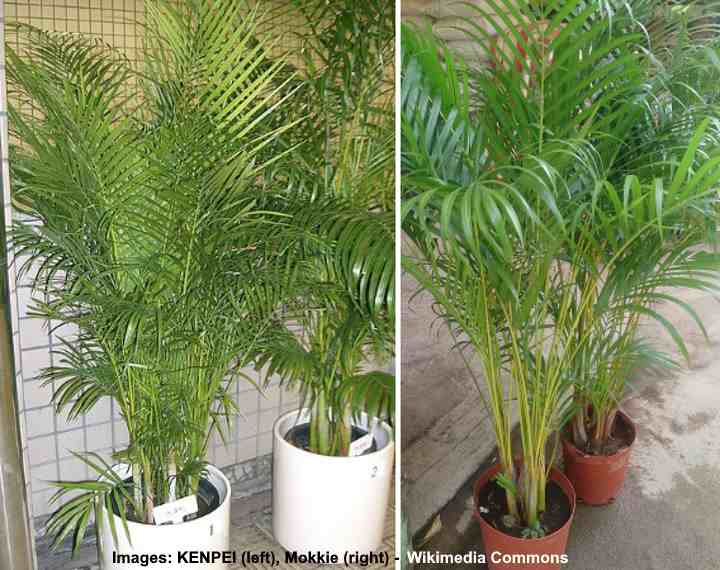
The areca palm can be grown indoors as a potted plant which restricts its size
The areca palm has a medium growth rate and thrives in full sun or partial shade. The palm plant grows outdoors 10 to 30 ft. (3 – 10 m). This type of palm tree is known for its tolerance to a wide range of well-draining soil types, making it adaptable to various garden conditions.
Due to its moderate size and attractive appearance, the Areca palm is often used as a focal point in gardens, as a border plant, or as a potted plant for indoor or outdoor spaces.
Other names for the palm plant include bamboo palm, butterfly palm, cane palm, and golden feather palm.
- Mature Size: 10 to 30 ft. (3 – 10 m)
- USDA Hardiness Zones: 10 and 11
- Sun Exposure: Full sun or partial shade
Ponytail Palm (Beaucarnea recurvata)
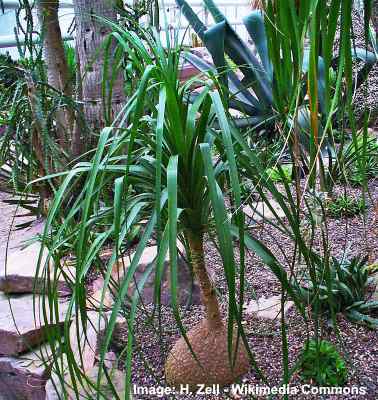
The ponytail palm is an eye-catching plant that adds a touch of tropical appeal to outdoor spaces. The palm’s name comes from its distinctive long, slender leaves that cascade down like a ponytail. The strappy, recurved leathery leaves grow up to 15 ft. (4.5 m) long and 0.78” (20 mm) wide, giving the plant its distinctive look.
Growing up to 8 ft. (2.4 m) tall, the slow-growing ponytail palm is easily recognizable due to its smooth gray trunk with a swollen trunk base. The sun-loving plant with its cascading green, linear leaves is ideal for container growing on a patio or deck.
- Mature Size: 6 to 8 ft. (1.8 – 2.4 m)
- USDA Hardiness Zones: 10 and 11
- Sun Exposure: Full sun or light shade
Dwarf European Fan Palm (Chamaerops humilis)

The dwarf European fan palm is one of the best outdoor palm plants for subtropical landscapes. The slow-growing small to medium-sized palm is identified by its cluster of stout, rugged trunks, huge fan-shaped blue-green or silver-green fronds, and bright yellow flowers in the spring. The compact landscaping palm grows up to 15 ft. (4.5 m).
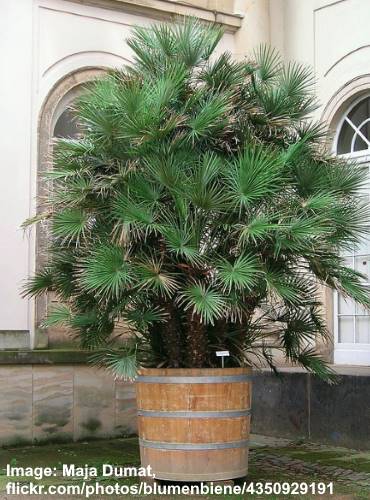
The dwarf European fan palm can be grown outdoors in a container and has a bushy appearance
The medium-sized, shrub-like European fan palm features a large, spreading crown, making it well-suited for landscaping. It’s native to Europe and is exceedingly drought and shade-tolerant, and the palm can survive extreme cold or heat. You can plant it as a container plant, specimen tree, or impenetrable hedge.
- Mature Size: 6 to 15 ft. (1.8 – 4.5 m)
- USDA Hardiness Zones: 9 to 11
- Sun Exposure: Full sun or partial shade
Pygmy Date Palm (Phoenix roebelenii)
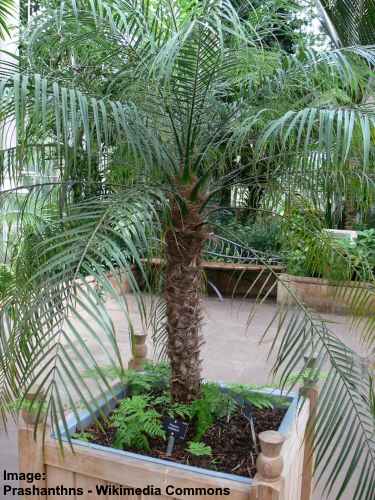
The pygmy date palm is a popular palm for planting outdoors due to its compact growth and dense crown of arching fronds. Also known as the miniature date palm, the small palm tree grows up to 10 ft. (3 m). Its feathery fronds grow up to 3 ft. (1 m) long.
The pygmy date palm plant is characterized by its single stem, long, bushy pinnate fronds, and rough trunk featuring diamond-shaped leaf bases. It’s easy to grow and requires little maintenance growing in well-drained soil. The short palm tree also thrives when planted in containers.
- Mature Size: 6 to 10 ft. (1.8 – 3 m)
- USDA Hardiness Zones: 9 to 11
- Sun: Full sun or partial shade
Christmas Palm (Adonidia merrillii)
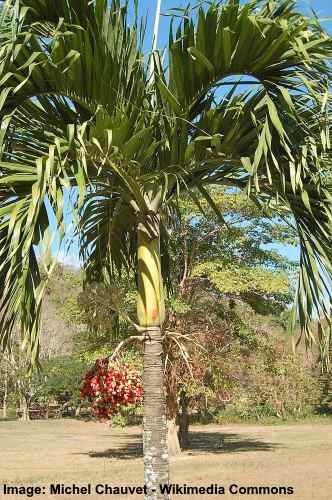
The Christmas palm is a popular palm plant in Florida known for its slender gray trunk and huge arching green fronds. The palm tree features bright, pinnately compound green fronds 5 ft. (1.5 m) long, creamy yellow flowers, and fruits that ripen to red in winter. This ornamental palm plant grows up to 25 ft. (7.5 m) tall.
Also called the dwarf royal palm, the Christmas palm gets its name from its bright red fruits. These mature from green to red in December. The evergreen palm blooms in mid-summer. Because it’s sensitive to frost, it’s best to plant the palm plant in containers and overwinter indoors in temperate climates.
- Mature Size: 15 to 25 ft. (4.5 – 7.5 m)
- USDA Hardiness Zones: 10 to 11
- Sun: Full sun
Parlor Palm (Chamaedorea elegans)
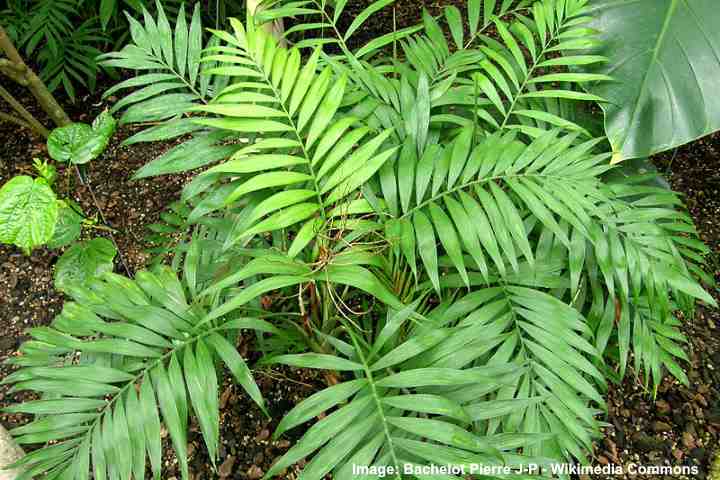
The parlor palm is a popular outdoor palm plant typically grown as a houseplant in cold climates. This small palm plant is identified by its pinnate, crescent-shaped leaves, yellow or red fragrant flowers, and pea-sized dark-colored fruits. Growing outdoors, the parlor palm plant grows up to 10 ft. (3 m) tall.
The parlor palm plant is ideal for planting in shaded areas. You can plant the palm as an understory plant, along a shaded foundation line, or in containers for a shaded patio or deck. Its dense evergreen foliage also makes the tropical palm perfect for privacy screens.
- Mature Size: 6.7 to 10 ft. (2 – 3 m)
- USDA Hardiness Zones: 10 to 12
- Sun Exposure: Indirect or filtered sunlight
Related reading: How to grow palm trees as houseplants.
Kentia Palm (Howea forsteriana)

The kentia palm is a popular houseplant that thrives outdoors in tropical landscapes. Its identifying features are its slender, smooth, erect stem, hardy feather-like drooping fronds with finger-like leaflets, and clusters of dangling white flowers. In subtropical and tropical climates, it grows up to 30 ft. (10 m).

Kentia palms can be grown outdoors in containers
Also called the thatch palm, most people recognize Kentia palms as evergreen houseplants for shaded areas. In indirect sunlight, the potted palm plant grows up to 12 ft. (3.6 m) but is usually much smaller. Its tolerance for low light conditions and minimal maintenance makes it a wonderful choice for adding greenery to indoor areas.
- Mature Size: 10 to 30 ft. (3 to 10 m)
- USDA Hardiness Zones: 9 to 11
- Sun Exposure: Partial shade to full shade
Sentry Palm (Howea belmoreana)

The sentry palm, or curly palm, is a small to medium-sized palm plant with versatile landscaping uses. The slow-growing palm is identified by its feather-like curved fronds, narrow growth habit, creamy-tan flowers, and coppery-brown fruits. The easy-to-grow palm is easy to confuse with the related Kentia palm.
The sentry palm tree is popular for landscaping due to its attractive appearance and ability to thrive in a variety of conditions. Keeping the sentry palm in a container will restrict its growth.
- Mature Size: Up to 40 ft. (12 m) outdoors or 10 ft. (3 m) in a container
- USDA Hardiness Zones: 9 to 11
- Sun Exposure: Partial shade to deep shade
Blue Palmetto (Rhapidophyllum hystrix)
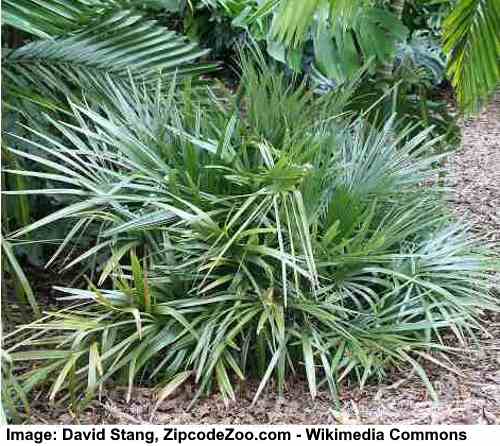
The blue palmetto is one of the easiest outdoor palm plants to grow. The small palm tree features blue-green, fan-shaped leaves 3 ft. (1 m) in diameter, spiny leaflets, and reddish-brown fruits. The low-growing palm plant grows up to 6 ft. (1.8 m) tall and is one of the hardiest palms for outdoor landscapes.
Also called the needle palm or porcupine palm, the blue palmetto is a slow-growing palm. Its common names come from its leafy growth. The palm fronds are a bluish color and have stiff, needle-like spines. The clumping palm plant is ideal for creating a privacy or security barrier.
- Mature Size: 3 to 6 ft. (1 to 1.8 m)
- USDA Hardiness Zones: 6 to 10
- Sun Exposure: Full sun to deep shade
Silver Saw Palmetto (Serenoa repens)
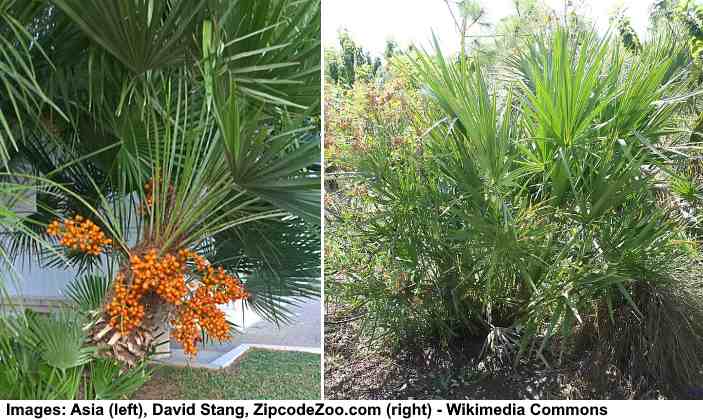
The silver saw palmetto is a short, multi-trunked palm plant with bright green, fan-shaped leaves ideal for outdoor landscaping. The palm’s characteristics are its creeping stems, fan leaves with 18 to 30 pointed segments and sharp spines, creamy-white flowers, and black berries when ripe. The slow-growing palm thrives in subtropical and warm climates.
The silver saw palmetto gets its name from the sharp spines along the silvery-gray leaf stems. The fan-shaped fronds grow up to 3 feet (0.9 meters) long. Thanks to its dense growth and sharp, jagged foliage, this handsome palm can be used as a foundation planting, privacy hedge, or security screen.
- Mature Size: 5 to 10 feet (1.5 to 3 m)
- USDA Hardiness Zones: 8 to 11
- Sun Exposure: Full sun, partial shade, or full shade
Jelly Palm (Butia capitata)
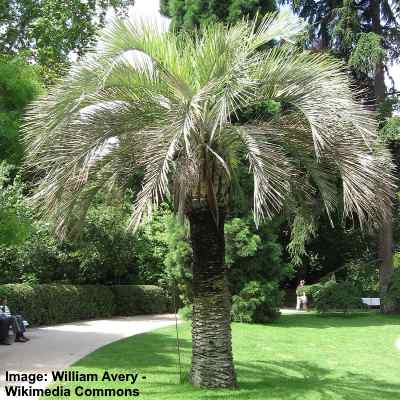
The jelly palm is a slow-growing evergreen palm plant with a stout, solitary, rugged trunk, and gray-green feather-like, arching leaves. This attractive landscaping palm is known for its clusters of creamy-yellow flowers and orange-yellow edible date-like fruits. It is suitable for drought-prone coastal landscapes in warm climates.
- Mature Size: 10 to 20 feet (3 – 6 m)
- USDA Hardiness Zones: 9 to 11
- Sun Exposure: Full sun or partial shade
Lady Palm (Rhapis excelsa)

The lady palm is an outdoor palm plant with distinctive bamboo-like canes, fan-shaped leaves, and tiny yellow flowers. Also known as ground rattan, fern rhapis, or miniature fan palm, the shade-loving palm is hardy to 18°F (-7°C), slow-growing, and requires little maintenance. It’s also a popular indoor potted palm plant.
- Mature Size: 6 to 15 ft. (1.8 – 4.5 m)
- USDA Hardiness Zones: 9-11
- Sun Exposure: Partial shade to full shade
Dwarf Palmetto (Sabal minor)
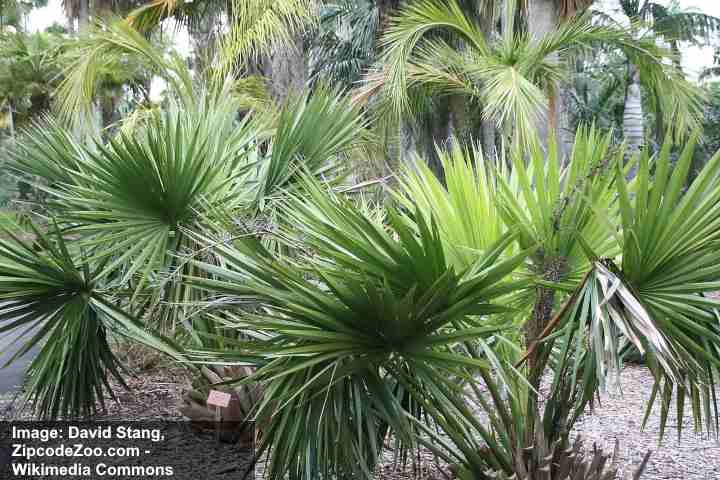
The dwarf palmetto is a cold-hardy palm plant with large fan-shaped leaves, creamy-white flowers, and low height. This small evergreen palm doesn’t grow taller than six feet (1.8 m). Its fan-like fronds are 3 ft. (1 m) in diameter and have 30 to 40 narrow pointed segments.
Also called scrub palmetto, bush palmetto, or swamp palmetto, this sun-loving ornamental palm plant tolerates soil with poor drainage. You can plant the attractive palm as a foundation plant or textural accent. It also thrives in shaded areas where other palm plants struggle to grow outdoors.
- Mature Size: 4 to 6 ft. (1.2 – 1.8 m)
- USDA Hardiness Zones: 7 to 10
- Sun Exposure: Partial shade to full shade
Related reading: Popular palm trees native to Texas.
Chinese Fan Palm (Livistona chinensis)
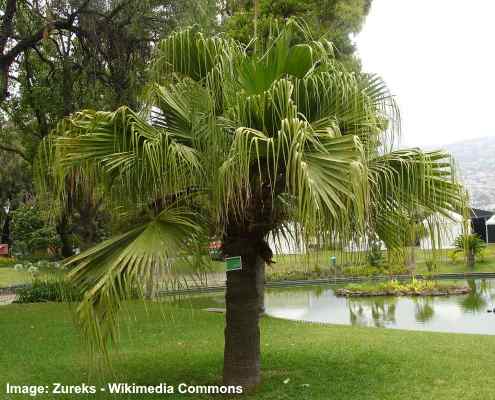
The Chinese fan palm is an eye-catching palm tree with cascading palmate leaves. Identifying features of the evergreen palm are its coarse textured fronds, spiny petioles, huge sprays of creamy-white fragrant flowers, and dark blue fruits. The unusual palm has a weeping habit, making it attractive for garden landscapes.
The Chinese fan palm is one of the easiest palm plants to grow. It has a single trunk covered in brown fibers. Its large drooping fan-shaped fronds give the plant a unique and distinctive look. It also performs well in containers to decorate a decking area or patio.
- Mature Size: 10 to 20 ft. (3 – 6 m)
- USDA Hardiness Zones: 10 to 11
- Sun Exposure: Full sun to partial shade
Lipstick Palm (Cyrtostachys renda)
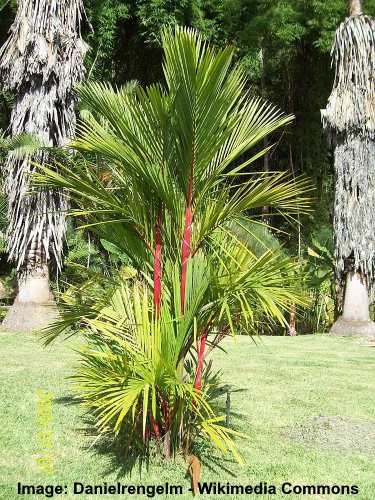
The lipstick palm is a distinctive palm plant with a striking bright green crown shaft, bright red trunk, and arching pinnate fronds. This medium-sized palm tree produces deep green foliage, pale green flowers, and small, egg-shaped black fruits. It is a stunning landscaping palm plant for tropical climates.
The easily recognizable lipstick palm can be used as a focal point, hedge, or screen. It thrives in high humidity and heat and is exceedingly cold-sensitive. Also, it’s not tolerant of drought, salt, wind, or excessive heat. Therefore, it’s one of the highest-maintenance palm trees. However, you can grow it easily as an indoor palm plant.
- Mature Size: 25 to 35 ft. (7 to 10 m)
- USDA Hardiness Zones: 10 to 11
- Sun Exposure: Full sun to partial shade
Bamboo Palm (Chamaedorea seifrizii)

Also known as the parlor palm or reed palm, this palm plant is ideal for growing in the ground in low-light areas. The palm’s distinctive features are its slender, cane-like stems and feathery, arching fronds that grow 6 ft. (1.8 m) long. It’s popular for indoor and outdoor landscaping due to its compact size and minimal maintenance requirements.
The bamboo palm is well-suited for growing in containers in temperate climates. Because the palm is not cold-tolerant, you can bring it indoors in the winter. The bamboo-like palm plant grows well in the garden as a hedge, border, or specimen plant.
- Mature Size: 10 to 12 ft. (3 – 3.6 m)
- USDA Hardiness Zones: 10 to 12
- Sun Exposure: Partial shade or dappled sunlight
Majestic Palm (Ravenea rivularis)
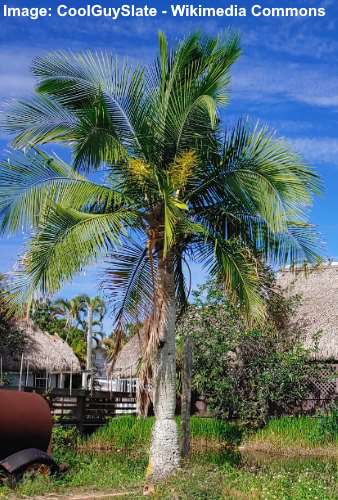
The majestic palm is a tall, elegant palm plant with beautiful feather-like leaves. Native to Madagascar, the majestic palm has a cylindrical trunk, huge arching fronds 10 ft. (3 m) long and airy sprays of creamy-white flowers. Due to its tall growth habit, it’s best to grow the tropical palm in a container to restrict its height.
The majestic palm is a popular choice for tropical and subtropical gardens, as it thrives in warm climates. In cooler climates, you can enjoy its beauty as an attractive houseplant. However, it has high humidity requirements when growing indoors.
Growing outdoors, the palm plant tolerates full sun to partial shade and is relatively low maintenance. This palm tree can grow up to 98 ft. (30 m) in forests. But it generally stays 16 – 72 ft. (5 – 22 m) in cultivation, making it a true statement piece in any garden.
- Mature Size: 16 to 98 ft. (5 – 30 m)
- USDA Hardiness Zones: 9 to 11
- Sun Exposure: Full sun to partial shade
Mexican Blue Palm (Brahea armata)
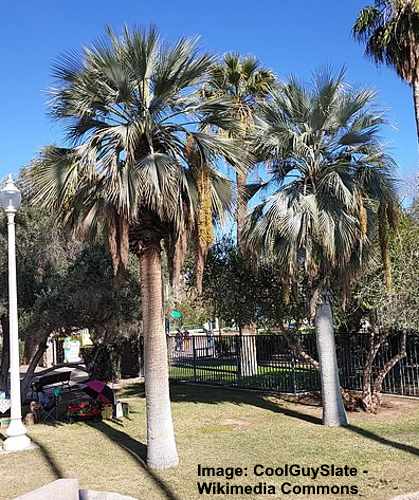
The Mexican blue palm is a stunning palm plant with bluish-green fan-shaped fronds for outdoor landscaping. This palm tree has 5 ft. (1.5 m) long fronds, with spiky leaves divided into 20 to 40 lobes. In summer, clusters of creamy-yellow flowers appear, measuring up to 15 ft. (4.5 m) long.
This palm species is native to the Baja California region of Mexico. Its tolerance for drought, heat, full sun, and strong winds makes the tropical palm suited to desert-like climates. It’s also a cold-hardy palm during short spells. In addition to its impressive blue-green foliage, the palm produces golden yellow fruits that mature to black.
- Mature Size: 20 to 40 ft. (6 – 12 m)
- USDA Hardiness Zones: 9 to 11
- Sun Exposure: Full sun
Baby Queen Palm (Chamaedorea plumosa)
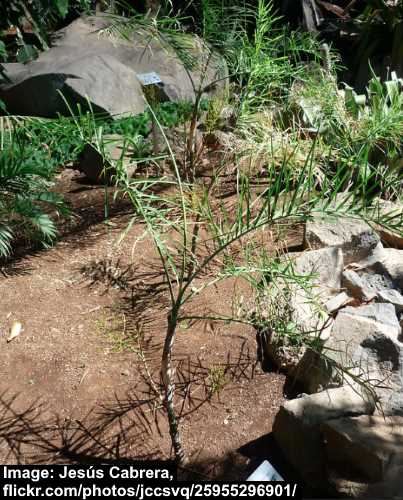
A young tree of baby queen palm
The baby queen palm tree is a slender-trunked plant that adds a tropical touch to garden landscapes. Characteristics of the palm are its long, arching, feathery fronds with narrow leaflets, slender, smooth trunk, yellow flowers, and black palm fruits. The lush green fronds can grow up to 6 ft. (1.8 m) long.
The fast-growing baby queen palm plant grows up to 12 ft. (3.6 m). It is an excellent choice for small gardens or as an accent plant in larger landscapes. With its compact growth, this palm tree is also well-suited for growing in containers, making it a versatile option for patios or indoor spaces. Its graceful fronds give landscapes a tropical appearance.
- Mature Size: 10 to 12 ft. (3 – 3.6 m)
- USDA Hardiness Zones: 9 to 11
- Sun: Full sun or partial shade
Discover the best potted palm trees for outdoors.
Related articles:
